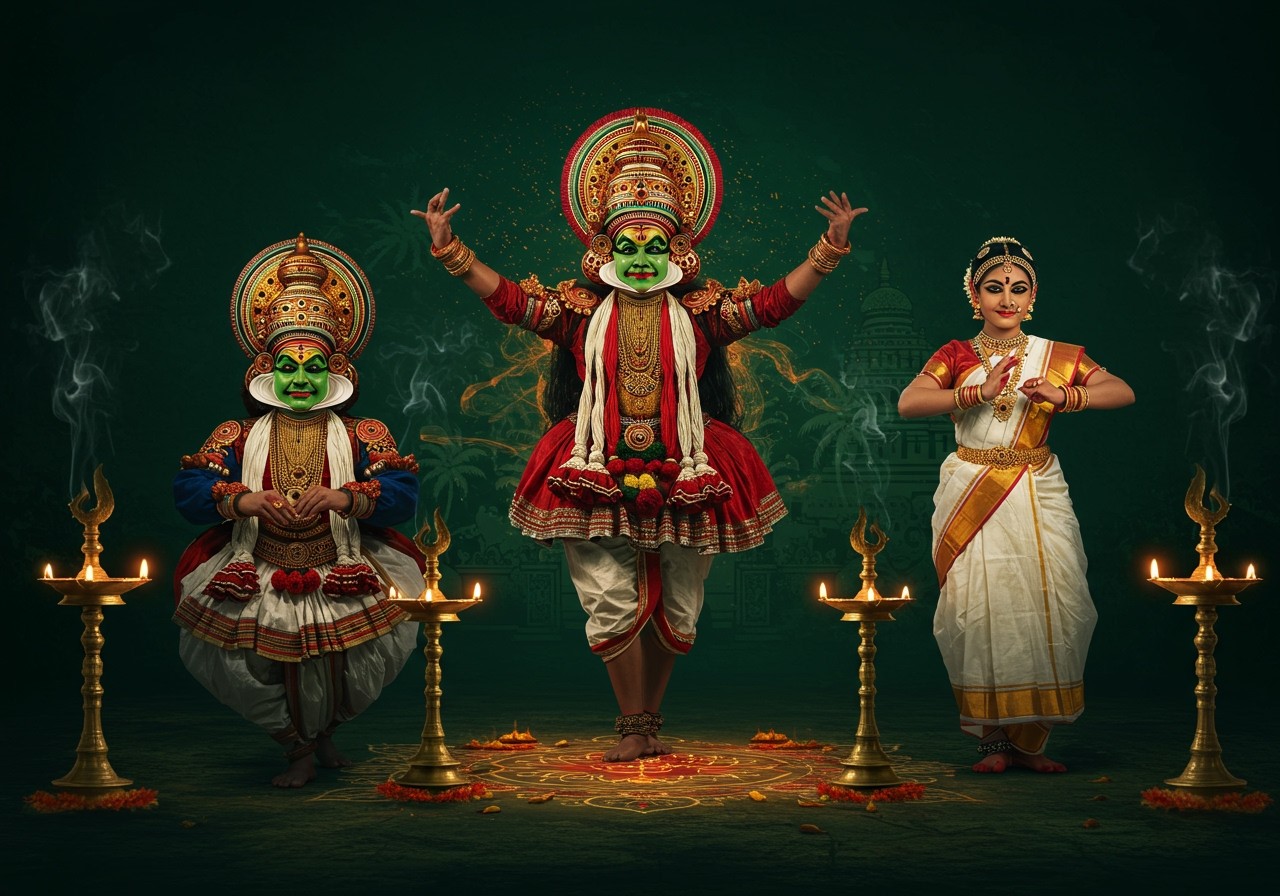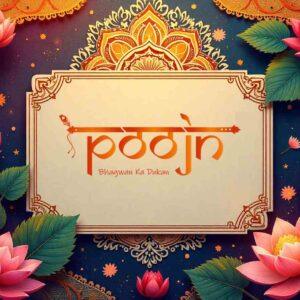
Kerala, fondly known as “God’s Own Country,” is renowned for its breathtaking landscapes and vibrant cultural heritage. This southern Indian state beautifully blends tradition with modernity. Let’s embark on a captivating exploration of Kerala’s traditional performing arts, delving into the vibrant expressions of Theyyam, the graceful movements of Mohiniyattam, and the energetic displays of Puli Kali, among other art forms.
These art forms not only showcase Kerala’s rich cultural tapestry but also play a vital role in preserving its traditions for generations to come. They offer a glimpse into the heart and soul of Kerala, where stories are told, history is celebrated, and communities come together in joyous celebration. These traditions are deeply woven into the fabric of Kerala’s diverse communities, encompassing Hindu, Christian, and Muslim artistic expressions.
Kerala’s Traditional Performing Arts: A Tapestry of Culture
Kerala’s traditional performing arts are more than just entertainment; they represent the state’s diverse cultural heritage. Each art form, whether it’s the enchanting Mohiniyattam or the spirited Oppana, carries stories from the past into the present. They connect communities, celebrate shared histories, and keep traditions alive. Let’s explore some of these captivating art forms and their unique characteristics.
Hindu Arts
- Kathakali: A UNESCO-recognized dance-drama, Kathakali is renowned for its elaborate costumes, makeup, and storytelling. It combines elements of ballet, opera, masque, and pantomime, creating a mesmerizing spectacle. Originating in the 17th century from Ramanattam and Krishnanattam, Kathakali narrates epic tales with intricate gestures and expressions.
- Mohiniyattam: Known as the “dance of the enchantress,” Mohiniyattam embodies grace and femininity. This classical dance, mainly performed by women, expresses themes of love and beauty through fluid movements and emotive expressions. Rooted in Kerala’s temple traditions, it exudes elegance and spiritual depth.
- Koodiyattam: As the sole surviving tradition of Sanskrit drama, Koodiyattam holds immense cultural significance. It showcases elaborate gestures and expressions, preserving the ancient Sanskrit language and literature. With roots tracing back centuries, Koodiyattam represents a precious legacy.
- Theyyam: Theyyam is a vibrant ritualistic art form, primarily practiced in North Malabar. Performers embody deities through elaborate costumes and makeup. Each Theyyam represents a unique deity or mythical figure, narrating stories from Hindu mythology. The performances are visually stunning, with powerful expressions and intricate rituals.
- Thullal: This satirical performance art combines dance, music, and social commentary. Thullal offers a unique blend of entertainment and social reflection, often using humor to address societal issues. It’s known for its wit and engaging storytelling.
- Kalaripayattu: One of the oldest martial arts in India, Kalaripayattu is a testament to Kerala’s warrior traditions. It combines physical agility with spiritual discipline, emphasizing both strength and focus. This ancient art form is deeply embedded in Kerala’s history.
- More Traditional Hindu Art Forms: Kerala’s artistic landscape is incredibly rich, with numerous other Hindu traditions including Chakyar Koothu, Nangiar Koothu, Thirayattam, Padayani, Mayilpeeli Thookkam, Thiyyattu, Kerala Natanam, Panchavadyam, Tholpavakoothu, Ottamthullal, Garudan Thookkam, Kolam Thullal, Kakkarissi Nadakam, Poorakkali, Mudiyett, Kummattikali, Kuthiyottam, Thiriyuzhichil, Mangalamkali, Marathukali, Malayikuthu, Mukkanchathan, Charadupinnikkali, Kothammuriyattam, Sopanam, Thacholikali, Sarpam Thullal, Pulluvan Paattu, Poothan and Thira, Krishnanattam, and Thiruvathira. Each offers unique insights into Kerala’s cultural heritage.
Christian Arts
- Margam Kali: A graceful dance performed by women in a circle, Margam Kali embodies unity and faith. It often depicts stories from the Bible, expressed through song and dance. The circular formation symbolizes community and togetherness.
- Chavittu Nadakam: Chavittu Nadakam is a powerful theatrical form known for its rhythmic foot stamping, often depicting Christian legends and stories. This dynamic art form combines energetic performances with powerful storytelling. Its unique style leaves a lasting impression on the audience.
- More Traditional Christian Arts:Kerala’s Christian communities also express their traditions through art forms like Parichamuttukali and the soulful melodies of Slama Carol, showcasing the vibrant intersection of faith and artistic expression.
Muslim Arts
- Oppana: Oppana, a vibrant and joyous dance performed during Muslim weddings, celebrates new beginnings. Women clap, sing, and dance around the bride, creating a festive atmosphere filled with blessings and joy. It is a colourful and celebratory tradition.
- Mappila Pattu: These traditional Muslim songs, known as Mappila Pattu, narrate historical events and express deep emotions. The rhythmic tunes and soulful lyrics resonate with the rich cultural heritage of Kerala’s Muslim community. Mappila Pattu offers a captivating window into history and tradition.
- More Traditional Muslim Arts: From the rhythmic movements of Kolkali and Duff Muttu to the energetic Arabana Muttu, Muttum Viliyum, and Vattapattu, Kerala’s Muslim communities showcase a diverse array of artistic traditions.
These art forms frequently grace festivals and celebrations across Kerala. They showcase the state’s rich cultural tapestry and bring people together in celebration and reverence. From the dramatic expressions of Kathakali to the joyful rhythms of Oppana, each performance tells a story, resonating with both tradition and modernity.
Shop Traditional Kerala Puja Items at Poojn.in
To enhance your connection with Kerala’s rich cultural traditions, Poojn.in offers a wide selection of authentic Kerala ritual items. Our carefully curated collection includes:
- Pure brass Kerala-style nilavilakku (traditional lamps)
- Authentic Kerala-style puja thali sets
- Natural wicks for temple lamps
- Pure copper kalash with Kerala designs
- Bamboo Stick Katha (Beter Katha)
- Traditional Keya Kouto (Sindur Dibbi)
- Kalash Kumkum Roli
- Traditional bell metal utensils
We deliver these sacred items across India, making it convenient for you to uphold Kerala’s cultural legacy in your home. All products are quality-assured and securely packaged for safe delivery. We ship from our store in Boardangi, East Belbari, Belbari, Gangarampur, South Dinajpur.
To order your Kerala puja items:
- Visit: www.poojn.in
- Call: 03369029784
- WhatsApp: 9476142738
Our experts are available to assist you in selecting the appropriate items for specific Kerala rituals and art ceremonies. For bulk orders or special requests, please contact us directly. We maintain a consistent stock of essential Kerala puja items throughout the year.
Embracing Kerala’s Cultural Legacy
Kerala’s traditional performing arts are more than mere entertainment; they form a living tapestry of the state’s rich cultural heritage. Each art form, from the enchanting Mohiniyattam to the vibrant Oppana, carries stories from generations past. They connect communities, celebrate shared histories, and keep traditions alive, enriching the cultural landscape of Kerala. Witnessing these performances offers a glimpse into the heart and soul of Kerala, a land where rhythm and tradition intertwine beautifully.
FAQs on Kerala’s Rhythms
What is Puli Kali Dance? Puli Kali, meaning “play of the tigers,” is a vibrant folk art performed during Onam. Performers paint their bodies like tigers and leopards, dancing energetically to traditional drumbeats. This lively performance symbolizes bravery and valor.
How is Theyyam performed? Theyyam is a ritualistic art form where performers embody deities or mythical figures. They wear elaborate costumes, intricate face paint, and ornate headdresses. Through dance, music, and mime, they enact stories from mythology, offering blessings to the community.
What makes Mohiniyattam unique? Mohiniyattam is a graceful classical dance, primarily performed by women. It’s known for its gentle movements, emotive expressions, and emphasis on ‘lasya,’ the feminine aspect of dance. It often portrays themes of love and devotion.
Why is traditional art important in Kerala? Traditional art forms are integral to preserving Kerala’s rich cultural heritage. They offer a powerful medium for communities to express their beliefs, stories, and traditions, strengthening cultural identity and unity.
Where can I experience these performances? Many of these art forms are performed during festivals and celebrations throughout Kerala. Check local event listings and temple schedules for opportunities to witness these traditions live. You can also find recordings and live streams online, allowing you to appreciate Kerala’s cultural richness from anywhere in the world.


